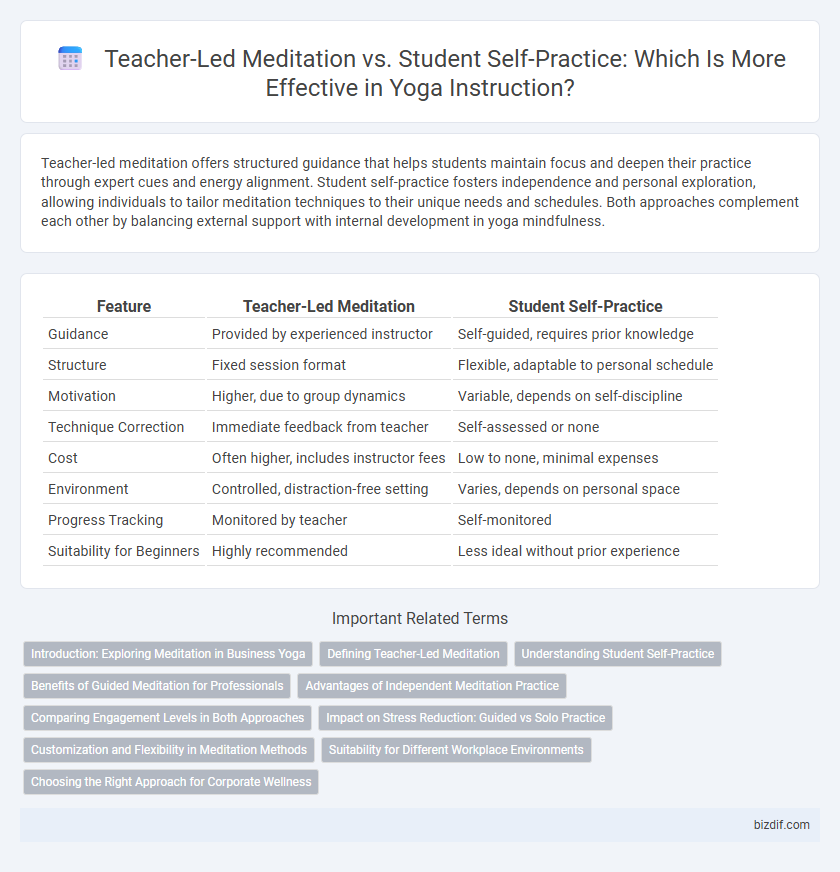Teacher-led meditation offers structured guidance that helps students maintain focus and deepen their practice through expert cues and energy alignment. Student self-practice fosters independence and personal exploration, allowing individuals to tailor meditation techniques to their unique needs and schedules. Both approaches complement each other by balancing external support with internal development in yoga mindfulness.
Table of Comparison
| Feature | Teacher-Led Meditation | Student Self-Practice |
|---|---|---|
| Guidance | Provided by experienced instructor | Self-guided, requires prior knowledge |
| Structure | Fixed session format | Flexible, adaptable to personal schedule |
| Motivation | Higher, due to group dynamics | Variable, depends on self-discipline |
| Technique Correction | Immediate feedback from teacher | Self-assessed or none |
| Cost | Often higher, includes instructor fees | Low to none, minimal expenses |
| Environment | Controlled, distraction-free setting | Varies, depends on personal space |
| Progress Tracking | Monitored by teacher | Self-monitored |
| Suitability for Beginners | Highly recommended | Less ideal without prior experience |
Introduction: Exploring Meditation in Business Yoga
Teacher-led meditation in business yoga provides structured guidance, enhancing focus and reducing workplace stress by following expert cues. Student self-practice encourages autonomy, allowing individuals to tailor meditation techniques to personal needs, fostering long-term habit formation and resilience. Both approaches integrate mindfulness into professional settings, promoting productivity and emotional balance.
Defining Teacher-Led Meditation
Teacher-led meditation involves guided sessions where an instructor directs participants through breathing techniques, visualizations, and mindfulness exercises to enhance focus and relaxation. These structured practices provide real-time feedback and support, helping students maintain proper posture and deepen their meditative experience. Teacher-led meditation is particularly effective for beginners seeking clear guidance and a supportive environment to establish a consistent practice.
Understanding Student Self-Practice
Understanding student self-practice in yoga requires recognizing its role in fostering independence and deepening internal awareness beyond structured teacher-led sessions. Self-guided meditation allows students to personalize their practice, adapting techniques to individual needs and rhythms, which cultivates consistency and self-discipline over time. Empowering students with tools for self-practice enhances long-term benefits such as stress reduction, emotional balance, and improved mindfulness outside the classroom setting.
Benefits of Guided Meditation for Professionals
Guided meditation led by experienced yoga instructors enhances focus, reduces stress, and improves emotional resilience for busy professionals. This structured approach offers personalized cues and real-time adjustments, ensuring deeper relaxation and effective mindfulness practice. Professionals benefit from the accountability and motivation provided by teacher-led sessions, fostering consistent meditation habits and long-term mental well-being.
Advantages of Independent Meditation Practice
Independent meditation practice empowers students to cultivate mindfulness consistently, adapting the technique to their unique needs and schedules. This self-directed approach fosters deeper self-awareness and autonomy, enhancing personal growth beyond structured sessions. Regular solo meditation supports lasting stress reduction and emotional resilience by reinforcing skills developed under teacher guidance.
Comparing Engagement Levels in Both Approaches
Teacher-led meditation sessions typically foster higher engagement levels through structured guidance and real-time feedback, effectively supporting beginners and those seeking focused mindfulness practice. Student self-practice allows for greater flexibility and personalization, but may result in inconsistent engagement due to a lack of external accountability and direct instruction. Research indicates that combining both approaches can optimize engagement by balancing guided support with autonomous exploration.
Impact on Stress Reduction: Guided vs Solo Practice
Teacher-led meditation offers structured guidance that enhances stress reduction by providing real-time correction and support, making it suitable for beginners or those experiencing high anxiety levels. Student self-practice allows greater flexibility and fosters independence, which can cultivate long-term stress resilience through consistent personal commitment. Research shows that combining both methods maximizes benefits, as guided sessions help establish techniques while solo practice deepens individual mindfulness skills.
Customization and Flexibility in Meditation Methods
Teacher-led meditation sessions offer structured guidance and personalized adjustments, ensuring techniques align with individual experience levels and goals. Student self-practice provides maximum flexibility, allowing practitioners to tailor meditation duration, style, and pacing based on daily needs and preferences. Combining both approaches fosters a balanced meditation routine that enhances customization and adapts to evolving mindfulness objectives.
Suitability for Different Workplace Environments
Teacher-led meditation sessions provide structured guidance ideal for corporate settings where employees may lack prior experience or require focused stress relief. Student self-practice offers flexibility suited to remote or hybrid work environments, allowing individuals to tailor sessions to personal schedules and preferred meditation styles. Workplaces prioritizing consistency and collective mindfulness often benefit more from instructor-led formats, while diverse or high-autonomy environments favor self-directed meditation approaches.
Choosing the Right Approach for Corporate Wellness
Teacher-led meditation sessions provide structured guidance and expert techniques that can enhance focus and reduce workplace stress effectively. Student self-practice offers flexibility, enabling employees to integrate mindfulness practices into their schedules independently, fostering autonomy and sustained wellness habits. Selecting the right approach for corporate wellness depends on balancing organizational goals with employee preferences to maximize engagement and mental health benefits.
Teacher-Led Meditation vs Student Self-Practice Infographic

 bizdif.com
bizdif.com